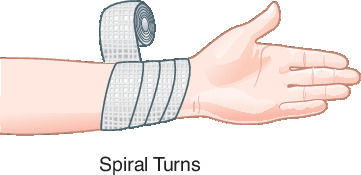Musculoskeletal Injuries and Your go-to Guide to the Art of Bandaging 🩹🤕
- Olivia Dahan

- Oct 27, 2020
- 3 min read
In this week's blog, we will focus on bandaging and different types of musculoskeletal injuries. We will furthermore observe treatments and preventions of such injuries.

Dressings / Bandages:
-Adhesive dressings: used mainly for small wounds.

-Gauze dressings: thick, cotton pads used to cover larger wounds. They are held in place with tape or by wrapping with a gauze strip.

-Roller bandages: are long strips of material.
-Tubular bandages: are used on fingers and toes because those areas are difficult to bandage with gauze. They can also be used to keep dressings in place on the elbow or knee.

-Triangular bandages: They are made of cotton or disposable paper and they are used for applying pressure to a wound to control bleeding.
Bandaging Forms

Circular bandaging: used to hold dressings on body parts such as arms, legs, chest or abdomen or for starting others bandaging techniques. Use gauze roller bandage or triangular bandage.

2. Spiral bandages: used for cylindrical parts of the body. They use roller bandages.

3. Figure-of-eight bandaging: involves two turns, with the strips of bandage crossing each other at the side where the joint flexes or extends. It is usually used to bind a flexing joint or body part below and above the joint. Also use roller bandages.

4. Recurrent bandaging: is used for blunt body parts consists partly of recurrent turns. Use roller or triangular bandages.
5. Reverse spiral bandage: is a spiral bandage where the bandage is folded back on itself by 180° after each turn. Use non elasticated bandages.
Visual Video approx. 20 minutes that explains types of bandages/dressings and goes over some bandaging techniques.
Main types of musculoskeletal injuries
1. Soft tissue injuries : they include all body tissue except bones (i.e. skin, muscles, ligaments,...) Examples of soft tissue injuries are scarped knees and can even go up to critical injuries such as internal bleeding.
2. Closed wounds: In a closed wound, the soft tissue below the skin surface is damaged, but there is no break in the skin. Examples include:
***Edema: swelling as a result of inflammation or abnormal fluid under the skin.
***Strain: stretching or tearing of a muscle resulting from over-stretching or overexertion. Also known as a pulled muscle or torn muscle
***Ecchymosis: discolouration under the skin that is caused when blood leaks out into the surrounding soft tissues causing the skin to turn different colours.
Closed injuries can be managed by applying the Rest Ice Compression Elevation Referral for appropriate medical treatment (RICER) principle.
3. Open wounds: An open wound is an injury involving an external break in body tissue, usually involving the skin. Examples include:
***Abrasions: where the top layer of the skin is removed.
***Amputations: partial or full detachment of a limb or other appendage of the body which may be iatrogenic or due to trauma.
Abrasions can be treated by cleansing the wound and depending on the severity of the wound we would apply different types of bandages/dressings.
Amputations can be treated by starting with the ABCDE principle, which is the management of airway, breathing, circulation, disabilities, and environment. In severe cases where the patient’s life might be at compromise, a tourniquet may remain in place for a prolonged period in order to save the patient’s life. The physician must be able to make such decision and be aware that this choice is for life and against limb.
4. Fractures: A break in the continuity of bone which may result in partial or complete disruption of the bone. There are open and closed fractures:
Open: The bone pokes through the skin and can be seen.
Closed: The bone is broken, but the skin is intact.
Guidelines for fractures:
-start with the ABCDE principle (as mentioned above)
-control hemorrhage
-treatment for shock
-relieve pain
-treat any associated injuries and cover the injured area with sterile dressing
-immobilize the fracture using splints
-check pulse, motor, and sensation (PMS) ...
Complications of open fractures include: soft tissue infection, tetanus, skin loss, osteomyelitis (infection in bone), crush syndrome (major shock and kidney failure)...
5. Dislocations: dislocations are joint injuries that force the ends of your bones out of position.
***Symptoms include: limited or lost motion, pain during movement, numbness around the area and paresthesia (tingling feeling in the limb).
***Doctors will usually see the dislocations through X-rays.
***Management of dislocations include: manipulation or repositioning, immobilization, medication, rehabilitation and surgery if there are damaged blood vessels.
For those who are interested here is a 40 minute video on musculoskeletal injuries:
One of musculoskeletal injury complication's
Acute compartment syndrome (ACS) : It is a painful condition caused by the increase interstitial pressure within a closed osteofascial compartment (includes tibia, fibula, inter-muscular septa, and deep fascia) which impair local circulation.
Treatment: urgent surgical exploration with fasciotomy (surgical procedure where the fascia is cut to relieve tension).
Note: the fascia is a thin casing of connective tissue that surrounds and holds every organ, blood vessel, bone, nerve fiber and muscle in place.



.png)



Comments